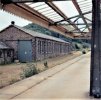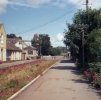Big Jumby 74
Established Member
If you haven't already, I would recommend you acquire a copy of the Middleton Press book "Branch Line to Ilfracombe" for the (unusually perhaps) large number of images of Ilfracombe station, even if your model will only have the minimal track layout that remained at the end.I’m going to model the Ilfracombe line and base it in the year 1970
I realised the same, after trawling through some of the books I have that include the line. The nearest I did find was a view in the aforementioned Middleton Press volume, taken from closer to the station, the goods shed being partially prominent in the right of view, possibly from the second signal box to be there (the final box being the third I believe), which would date said image to somewhere between the doubling of the line (1891) and the SR's rebuilding (platform lengthening etc) of 1929, but the platform is obscured by a departing train. (Some images in the MP book are undated, so one has to take a judgement call.....The earliest s/box seems to have been even closer to the end of the line, being adjacent to the country end of the goods shed - but I digress).I don’t think I have seen many, if any, photos taken from that angle.
For the modeller, the view I took does indicate how the ramp end of the 1929 platform extension does skew to the East slightly and also (as many views taken by others also bear out) the track bed alongside the goods shed wall, adjacent to the platform (outside of the canopy) rises, as indicated by gradually reducing depth of visible wall between the window sills and ground level, the climb up the bank starting within platform limits. The goods shed internal siding would have been on the level.
Thank you. I know some of my pics leave a lot to be desired, but with limited funds at the time etc......!What a wonderful snapshot in time
EDITED by me (BJ)
I spoke too soon! Gavin Morrison's "The Power of the Bulleid Light Pacifics", page 76, the potted history of 34072 (257 Squadron), a fine view from the box with said loco propelling empty stock from the carriage siding head shunt in to platform 2.I realised the same, after trawling through some of the books I have that include the line.
Attachments
Last edited:


